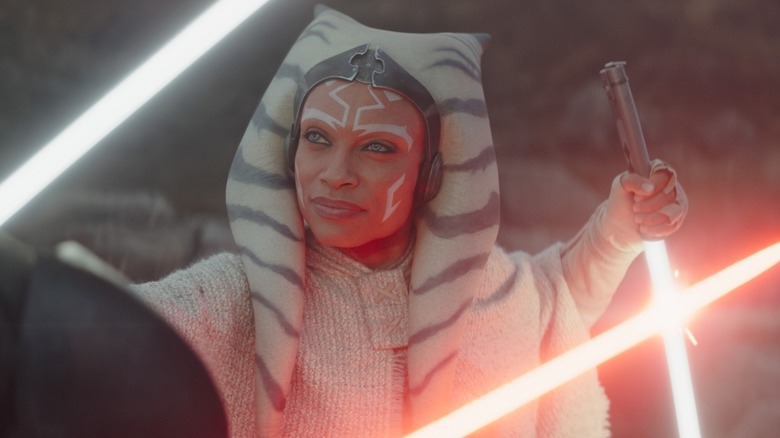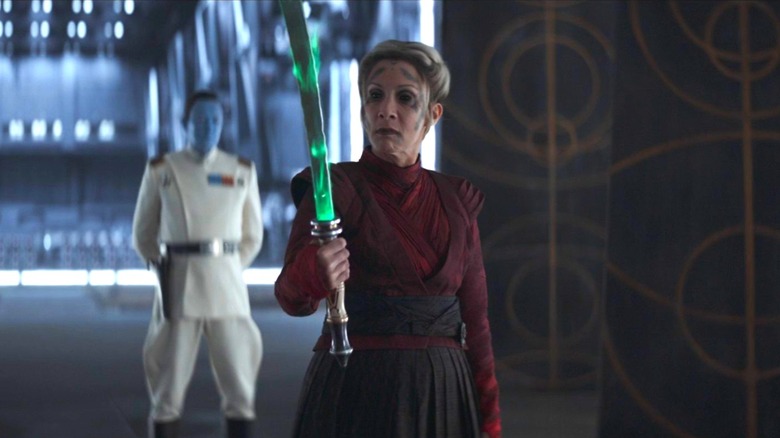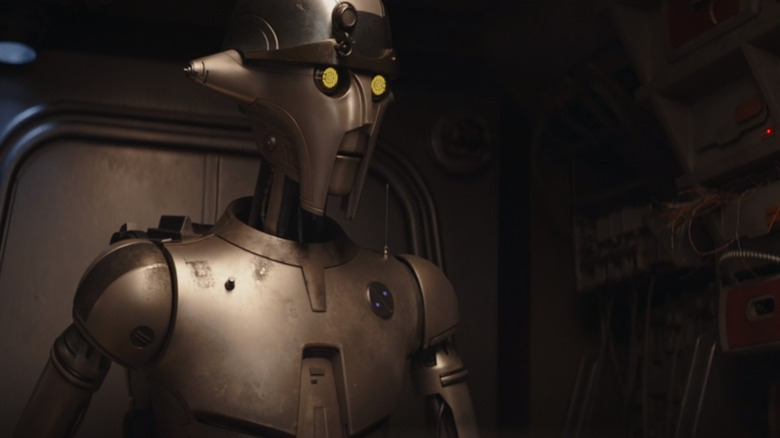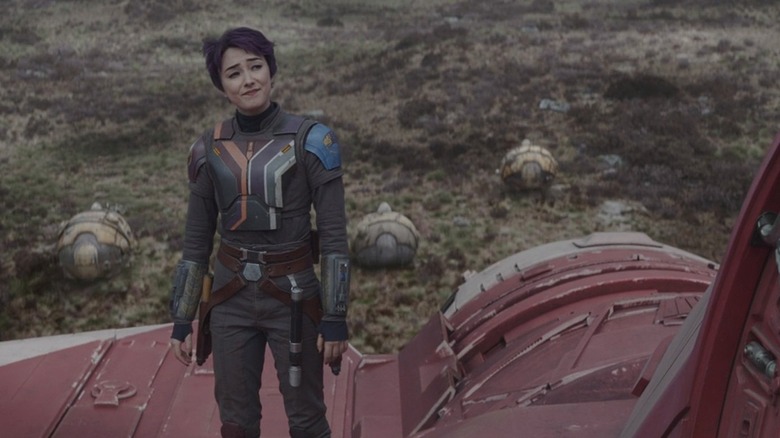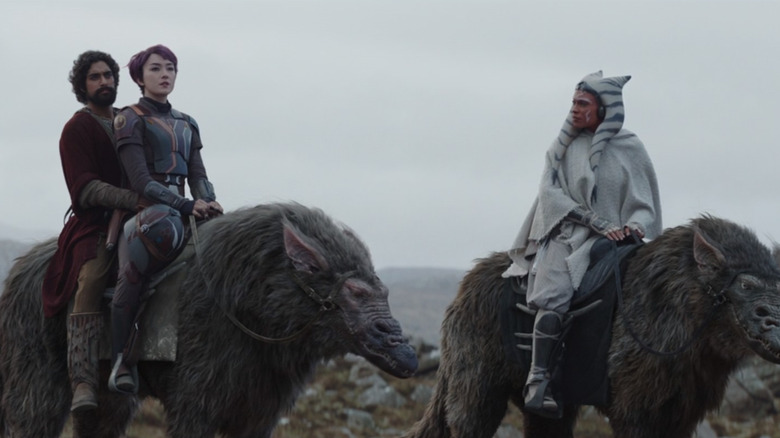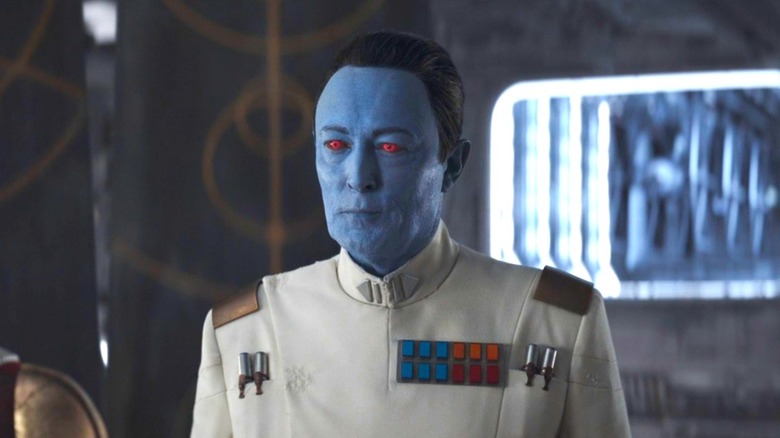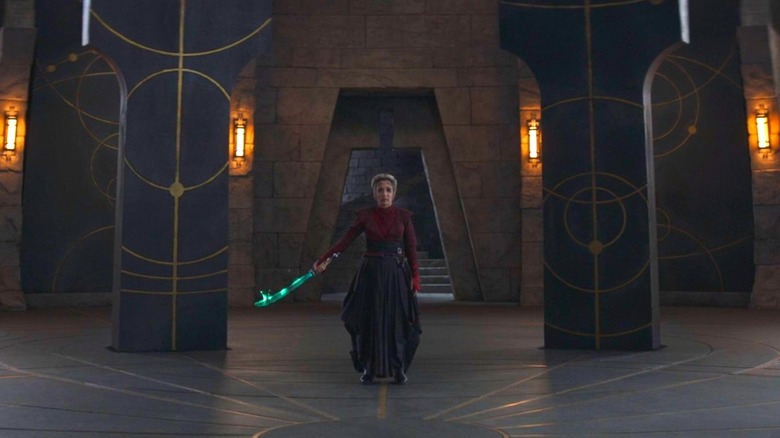Ahsoka Season 1 Finale Lines That Mean More Than You Realized
Contains spoilers for "Ahsoka" Episode 8 — "Part Eight: The Jedi, the Witch, and the Warlord"
After numerous lightsaber battles and hyperspace voyages, "Ahsoka" Season 1 is officially over. And while Lucasfilm has yet to confirm whether or not the "Star Wars" show will get more episodes, the Season 1 finale ends on a pretty big cliffhanger.
Ezra Bridger (Eman Esfandi) successfully manages to stow away with Grand Admiral Thrawn (Lars Mikkelsen) as he returns to the main galaxy, but Sabine (Natasha Liu Bordizzo), Ahsoka (Rosario Dawson), and Huyang (David Tennant) remain trapped on Peridea. Shin Hati (Ivanna Sakhno) also stays behind, joining one of the planet's bandit tribes. Baylan Skoll (Ray Stevenson) continues his quest for, well, we're not entirely sure what just yet. But yes, those were Mortis statues.
It's all a bit abrupt, but perhaps that's appropriate for a show that always seemed more interested in setting up future stories than telling a self-contained narrative of its own. One thing's for sure: "Star Wars" fans will have plenty to chew on while they wait for the next installment in the New Republic era, and that includes a few subtle Easter eggs and clues in Episode 8 itself. As we ponder the great mysteries hiding on Peridea and wait for Thrawn to strike his next blow, let's take a look at some "Ahsoka" Season 1 finale lines that mean more than you may have realized.
''The Blade of Talzin''
The opening scene of the "Ahsoka" Season 1 finale shows Morgan Elsbeth (Diana Lee Inosanto) being "rewarded" for her service by the Great Mothers (Claudia Black, Jeryl Prescott Gallien, and Jane Edwina Seymour). As all four characters are Nightsisters, it's only fitting that Morgan's prize be dark and magical in nature. After receiving a shadowy spell that gives her glowing green eyes and a cool tattoo to match her elders, she's given another gift — a sword.
This isn't just any sword, of course. The Great Mothers conjure it out of thin air, and when Morgan holds it, the blade ignites with green flame. They call it "the Blade of Talzin," and if you've seen "Star Wars: The Clone Wars," your ears probably perked up at that name.
Mother Talzin was the leader of the Nightsisters for many years, right up until the end of the Clone Wars. Or, at least, she was the leader of the Nightsisters of Dathomir — the ones who dwelled within the primary "Star Wars" galaxy. It's difficult to say whether or not Talzin would technically outrank the Great Mothers, and her own age at the time of her death was unknown. But clearly, the matriarchs respected her enough to attach her name to the sword when they give it to Morgan. Talzin only uses the weapon once in "The Clone Wars" in a duel with Mace Windu. It must have returned to the Nightsisters' ethereal plane after her death, waiting for its next worthy champion.
''Old enough to know...''
Morgan Elsbeth isn't the only character to get a new blade in "Ahsoka" Episode 8. Ezra also forges a new lightsaber for himself, crafting the weapon in Huyang's workshop. The droid even provides him with an identical emitter to the one his old master, Kanan Jarrus, used. The shot of Ezra igniting the blue lightsaber is enough to make any "Star Wars Rebels" fan a little teary.
In the same scene, Ezra seems amazed to learn just how old Huyang is. The droid mentions that he helped Kanan craft his own lightsaber once, but when Ezra asks his exact age, Huyang only responds vaguely. "Old enough to know that the relationship between a master and an apprentice is as challenging as it is meaningful," he says.
The truth, however, is far wilder. The canonical sourcebook "Star Wars: Timelines" claims that Huyang was first powered up in 25,020 BBY, placing his birth right around the same time as the beginning of the Jedi Order. That's right — Huyang puts Yoda's ancient status to shame. In fact, he helped Yoda build his lightsaber when the little green guy was just a little green youngling. He probably would have forgotten more about the Jedi than anyone could ever know, but since he's a droid, he probably hasn't forgotten a thing.
''Training as a Jedi for the wrong reasons''
After Huyang helps him build his new lightsaber, Ezra asks the droid what happened between Ahsoka and Sabine. It's an enlightening moment for the audience, too, as their schism hasn't yet been shown directly in any official "Star Wars" media. "Ahsoka became afraid that Sabine was training as a Jedi for the wrong reasons after what happened on Mandalore," Huyang says. "At the time, Ahsoka felt that if Sabine unlocked her potential, she could become dangerous."
If you've seen "The Mandalorian," you don't need Huyang's explanation of what happened on Mandalore — a genocidal Imperial purge that killed almost every Mandalorian, including Sabine's family. This loss likely hit her extra hard because, as shown in "Rebels," Sabine was ostracized by her family for years. The Imperial occupation of Mandalore forced her parents to disown her, and it took a lot of emotional work for Sabine to forgive them and accept them into her life again. Just a few years later, they and her brother were murdered in the purge.
Working so hard to regain her family, only to have them stripped away, must have been devastating. But Ahsoka's response is also interesting. It sheds more light on why she didn't want to train Grogu — another Mandalorian Jedi — and reveals just how terrified she was of losing another loved one to the dark side. After reuniting with Anakin in the World Between Worlds, however, she doesn't seem scared of that anymore.
''He woke up the witches''
Right before they charge into a barrage of Star Destroyer laser fire to try to stop Thrawn, Ahsoka asks Ezra if he has any intel about the mysterious temple or the villain's scheme. He says that, unfortunately, he has no idea, as approaching by himself was never feasible. But in his denial, he actually reveals something quite interesting. "Thrawn found this place," he says. "He woke up the witches, rebuilt his starship."
The idea that Thrawn didn't just find the Great Mothers but actually woke them up is curious. Woke them up from what? Were they in some kind of magical sleep? Were they dead, only resurrected by their own necrotic powers? We know from Mother Talzin and the other Nightsisters in "The Clone Wars" that powerful witches are capable of existing outside the material realm. It's not hard to imagine the Great Mothers entering some prolonger slumber, though that would beg questions as to how old they actually are.
Arguably more interesting is the larger implication of Thrawn finding the temple. What else did he wake up alongside the Great Mothers? Are those casket-shaped boxes piled high in his Star Destroyer even more sleeping witches, or maybe something even darker? Whatever the real answer, it's apparent that Thrawn has a full arsenal of dark magic on his side now.
''It is for the Empire -- the security of our galaxy''
One might wonder what exactly Thrawn is fighting for at this point. The Empire has fallen, after all, and the First Order is decades away from reaching full strength. Why does this Chiss — an alien in a tyrannical regime that was notoriously racist toward non-humans — still fight for its continuation? The "Ahsoka" Season 1 finale gives us a small hint at the answer.
After Morgan sends the "Night Troopers" to hold off Ahsoka, Ezra, and Sabine, Thrawn asks her if they realize that they'll die. "All were honored to make the sacrifice for you," she says, but he corrects her: "It is for the Empire — the security of our galaxy." If you've read any of the "Thrawn" novels by Timothy Zahn — canon or not — this line probably rings true. Thrawn has always been portrayed as someone who believes that tyranny is necessary in order to preserve order and security.
However, hidden in this line could be a reference to a more specific galactic threat: the Grysk Hegemony. Introduced in the canon novel "Thrawn: Alliances," the Grysks are a race of brutal conquerors from the Unknown Regions of the main "Star Wars" galaxy. Thrawn initially leaves his own home in the Chiss Ascendancy — also located in the Unknown Regions — to seek out allies against the Grysks. His search ultimately leads him to a high station within the Empire. Thrawn's line in the "Ahsoka" finale about galactic security suggests he might still have this mission in mind. Could this be the first clue that the Grysk Hegemony will be entering the live-action "Star Wars" universe?
''For Dathomir''
Morgan Elsbeth may not live to see the end of "Ahsoka" Episode 8, but she certainly goes down fighting. Ahsoka struggles to defeat her in their duel, and though the Jedi comes away victorious, it's clear that Morgan is fighting with an intense passion. Before their battle, she utters two simple words that suggest what exactly is going on in her mind: "For Dathomir."
In the moment, it seems like a simple battle cry. The Nightsister ruled the planet Dathomir for ages, right up until the Clone Wars, when Darth Sidious decided that Mother Talzin and her kin were too dangerous to his plans to be left alive. He ordered an attack that effectively wiped the witches out. Only a few survivors, including Morgan herself, kept the legacy going.
That bloody history is explanation enough for why Morgan would invoke Dathomir before going into battle with Mother Talzin's own sword. But the line gets even more meaning at the end of the episode. After returning to the main galaxy, Thrawn takes his ship directly to Dathomir itself, after which we see a panning shot of the mysterious boxes taken from the Great Mothers' fortress. It seems heavily implied that those crates are full of more sleeping Nightsisters who could repopulate Dathomir and return it to its former glory. If that ends up being true, then Morgan really is fighting for her planet when she faces Ahsoka.
